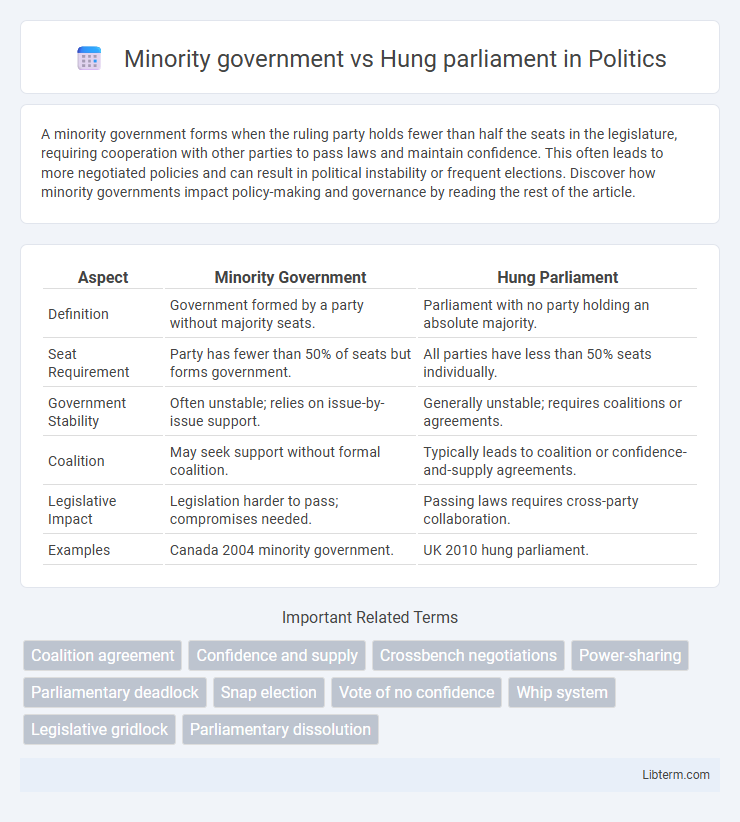A minority government forms when the ruling party holds fewer than half the seats in the legislature, requiring cooperation with other parties to pass laws and maintain confidence. This often leads to more negotiated policies and can result in political instability or frequent elections. Discover how minority governments impact policy-making and governance by reading the rest of the article.
Table of Comparison
| Aspect | Minority Government | Hung Parliament |
|---|---|---|
| Definition | Government formed by a party without majority seats. | Parliament with no party holding an absolute majority. |
| Seat Requirement | Party has fewer than 50% of seats but forms government. | All parties have less than 50% seats individually. |
| Government Stability | Often unstable; relies on issue-by-issue support. | Generally unstable; requires coalitions or agreements. |
| Coalition | May seek support without formal coalition. | Typically leads to coalition or confidence-and-supply agreements. |
| Legislative Impact | Legislation harder to pass; compromises needed. | Passing laws requires cross-party collaboration. |
| Examples | Canada 2004 minority government. | UK 2010 hung parliament. |
Introduction to Minority Governments and Hung Parliaments
Minority governments occur when a political party forms the government without holding a majority of seats in the legislature, relying on support from other parties to pass legislation. Hung parliaments refer to a situation where no single party secures an outright majority, resulting in a fragmented legislature requiring coalition-building or confidence agreements. Both minority governments and hung parliaments often lead to negotiated policymaking and increased political uncertainty.
Defining Minority Government
A minority government occurs when a political party holds fewer seats than the majority threshold in a legislative assembly but still forms the government, relying on support from other parties or independents to pass legislation. Unlike a hung parliament, where no single party achieves a majority and no government is immediately formed, a minority government operates with an active administration despite lacking absolute majority control. This arrangement often necessitates negotiation and compromise to maintain confidence and supply arrangements within the parliament.
What is a Hung Parliament?
A hung parliament occurs when no single political party secures an outright majority of seats in the legislature, leading to a situation where no one can govern alone. This contrasts with a minority government, where the ruling party holds less than half the seats but can still govern with support from other parties or independents. Hung parliaments often result in coalition talks or agreements to form a stable government.
Key Differences Between Minority Government and Hung Parliament
A minority government occurs when the ruling party holds fewer than half the seats but manages to govern with support from other parties, while a hung parliament arises when no single party wins a majority, resulting in a stalemate. In a minority government, power is concentrated in the ruling party, often relying on case-by-case agreements, whereas a hung parliament frequently leads to coalition negotiations or alliances to form a stable government. The key difference lies in governance stability: minority governments can function with external support, but hung parliaments risk prolonged uncertainty due to the absence of a clear majority.
Historical Examples of Minority Governments
Historical examples of minority governments include the 1974 UK Labour government led by Harold Wilson, which operated without an overall majority, relying on support from smaller parties. In Canada, Pierre Trudeau's Liberal Party governed with a minority from 1972 to 1974, navigating legislative challenges through strategic alliances. These cases illustrate how minority governments function differently from hung parliaments, where no party commands a clear majority, often leading to coalition negotiations or confidence agreements.
Notable Hung Parliaments in Political History
Notable hung parliaments in political history include the 2010 UK general election, which resulted in a hung parliament leading to a coalition government between the Conservative Party and Liberal Democrats. Another significant example is the 2017 Canadian federal election, producing a minority government by the Liberal Party without a clear majority. Historic Hungarian parliaments also exemplify hung states, particularly in Israel's 20th and 21st-century elections, where no single party achieved an absolute majority, causing complex coalition negotiations.
Advantages and Disadvantages of Minority Governments
Minority governments allow for more flexible policymaking since they must negotiate support from multiple parties, promoting collaboration and preventing dominance by a single party. However, their instability can lead to frequent elections and legislative gridlock, as they lack a clear majority to pass laws easily. The need for compromise may dilute policy effectiveness, but it can also reflect a broader range of interests in governance.
Challenges and Opportunities in a Hung Parliament
A hung parliament occurs when no single party secures an outright majority, leading to challenges in forming stable governments and passing legislation due to fragmented party interests. This scenario creates opportunities for coalition-building and power-sharing arrangements, enabling diverse political voices to influence policy decisions and foster compromise. However, the instability inherent in hung parliaments can result in frequent negotiations and potential government collapses, complicating long-term strategic planning.
Impact on Policy and Governance
Minority governments often struggle to pass legislation, requiring negotiation with opposition parties to secure support, which can slow policy implementation and result in compromised or diluted laws. Hung parliaments create uncertainty in governance, as no single party holds a majority, leading to coalition-building or confidence agreements that influence policy direction and stability. Both scenarios increase the likelihood of political gridlock and frequent elections, affecting long-term planning and consistency in government policies.
Conclusion: Navigating Minority Governments and Hung Parliaments
Navigating minority governments and hung parliaments requires strategic coalition-building and parliamentary negotiation to maintain legislative stability and governance effectiveness. Minority governments often rely on confidence-and-supply agreements to pass budgets and key legislation, while hung parliaments necessitate broader alliances among multiple parties to form a viable administration. Effective leadership and pragmatic compromise are essential to avoid political deadlock and ensure functional government in both scenarios.
Minority government Infographic

 libterm.com
libterm.com